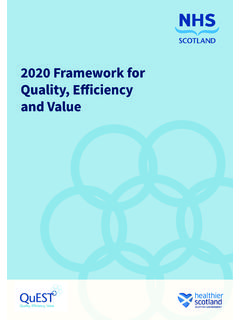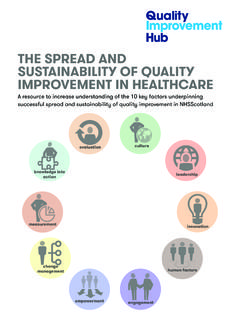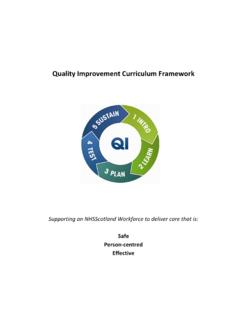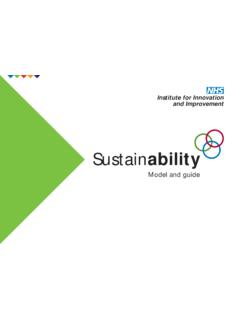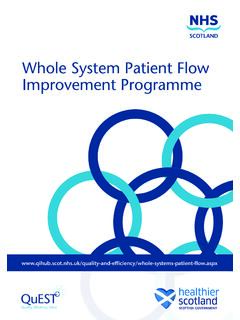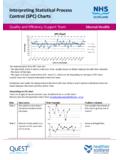Transcription of Dementia Post Diagnostic Support HEAT Target - QI …
1 QuEST. Q u a lity a n d E ffic ie n c y S u p p o rt T e a m Dementia Post Diagnostic Support HEAT Target Information flow mapping Guide February 2013. DRAFT. ID: A5110749 Version: 5 Page 1 of 11. Contents Background .. 3. Purpose of this 3. What is Information flow mapping ? .. 3. Why use Information flow mapping ? .. 4. How to carry out Information flow mapping in your area .. 4. Reporting .. 8. Engagement and Communication .. 9. Further information .. 9. 10. Appendix 1 Example of a Current State Detailed Information Flow Map .. 10. Appendix 2 Draft High Level Ideal State Information 11. ID: A5110749 Version: 5 Page 2 of 11. Background Improving post Diagnostic Support (PDS) is one of the two key improvement areas in Scotland's National Dementia Strategy1 (June 2010) and Standards of Care for Dementia in Scotland2 - Action to Support the change programme, Scotland's National Dementia Strategy (June 2011).
2 In April 2012, the Scottish Government announced its intention to introduce a post- Diagnostic Support HEAT Target to ensure people with Dementia receive the help they need following diagnosis. This HEAT Target will come into effect from April 2013. The national PDS dataset will be available on the Information Services Division (ISD) website shortly. Purpose of this Document The purpose of this document is to provide guidance to NHS boards and their key partners on a technique called Information flow mapping , that can be used to ensure systems are in place to capture the key data points for the measurement of the Target . What is Information flow mapping ? Process mapping can be defined as a way of developing a 'map' of a process within a system.
3 It will help you to map the whole patient journey or Diagnostic pathway with a range of people who represent the different roles involved in managing and delivering care using that process. Process mapping can be used to help a team understand what happens, where the process and system problems are, identify areas for improvement and assist with the design of improved processes. Information flow mapping is a subset of process mapping which aims to provide a pictorial representation of what data is collected along a process, and how information flows through a system. 1. 2. ID: A5110749 Version: 5 Page 3 of 11. Why use Information flow mapping ? Information flow mapping can be helpful in a number of ways.
4 It can help to: Document the current state (what actually happens, not what we think happens). This includes identifying: o where data is currently captured (may be multiple points). o who is involved in collecting data o gaps in data collection o duplication of data input o any confusion around definitional issues for data points o inconsistency in how people interact with information systems along a pathway Design a new process (ideal state) that ensures o all the relevant data is captured o duplication of data entry is removed o un-necessary data collection is stopped o there is clarity on roles attached to collecting data o there are clear definitions for data points o systems are in place to extract and collate the relevant data Inform the development of an action plan that will ensure all the key information is being collected in the most efficient way possible.
5 How to carry out Information flow mapping in your area Please note that this guidance presents it as a linear process moving smoothly from one step to the next. In reality, the process can be a lot more messy with you moving backwards and forwards between different steps as you develop a progressively better understanding of what is currently happening and what you actually want to happen. So don't worry if it doesn't all go so smoothly in practice, the key is that you understand what's currently happening, you agree what you want to happen and then you develop a plan to move from where you are to where you want to be. There are six key steps involved in information flow mapping : Step One - Obtain a process map of the current pathways to diagnosis and post Diagnostic Support (PDS).
6 This means you need to be clear: Which individuals/teams are currently involved/are you planning to involve in diagnosing Dementia (as you will need them to collect a variety of information around the referrals for diagnosis and the characteristics of individuals being diagnosed). Which individuals/teams are currently involved/are you planning to involve in providing the PDS link worker role (as you will need them to collect a variety of information around the actual provision of the PDS). ID: A5110749 Version: 5 Page 4 of 11. What is the pathway from those diagnosing and those providing PDS (so you can check that all those who diagnose have a clear pathway for accessing PDS). Who the Link workers are (teams/ settings/ employers etc).
7 Starting with a map of the current pathways is useful for a number of reasons;. It provides clarity around what happens with people interacting with the aspect of the care system being scrutinised, thereby immediately helping to identify areas for improvement. It can highlight any instability in the operational processes which need to be addressed. The clearer and more stable the underlying operational process, the easier it is to gather information from it in a systematic way. It serves to ensure that an information flow process is developed around an operational one and not vice versa it is rarely appropriate to design operational processes around data requirements. It frames the information flow mapping work in the right context the primary aim of service improvement work is to improve the quality of care we provide for individuals using our services.
8 Information flow mapping should not be viewed as an end in itself, but rather it should serve to give us the information we need to make the necessary improvements to, and reporting on, the system of care. Establishing the operational process first helps to keep your stakeholders focused on why information flow mapping is important. Step Two Understand what information is currently collected (current state). For those diagnosing Dementia and providing the PDS link worker role establish: What information is currently collected? Which systems are they currently collected in? Paper Clinical Case note, PiMS, HELIX, TRAK etc Is the same information collected by more than one person or in more than one person (duplication)?
9 What IT systems (if any) they use at present? Is it used across the whole NHS Board or are there gaps? There are a number of ways to do this. One approach is outlined below;. Identify who will undertake the initial scoping work, along with timescales. Use operational process map (see Step One) as basis of enquiry to begin with but be open to flexibility as these may not be right. Secure some time with key team lead(s) to get a general idea about the steps of the information-flow and produce a high level information flow. Using the high level draft, seek more in-depth information around each step by talking to admin staff (exact processes, trigger that identifies when to record data, what is recorded, time involved in recording, where it gets recorded and the type of person recording eg clinician, admin etc).
10 You now have enough information to produce a flow-chart of information recorded along the process. Formatting can be used to distinguish staff types, key transfer of care points, different information systems and so on. ID: A5110749 Version: 5 Page 5 of 11. Once this is developed, check it back with team leads to ensure it reflects the information they gave. NOTE the aim is not to seek consensus around each part of the system here. In fact, identifying differences in recording are very useful for the next steps. Where there are a range of differences in time, personnel involved, IT use and so on, these should be noted on the diagram. The aim is to have a current state information flow diagram that can be used as a focus of discussion when the key stakeholders meet to establish next steps.

